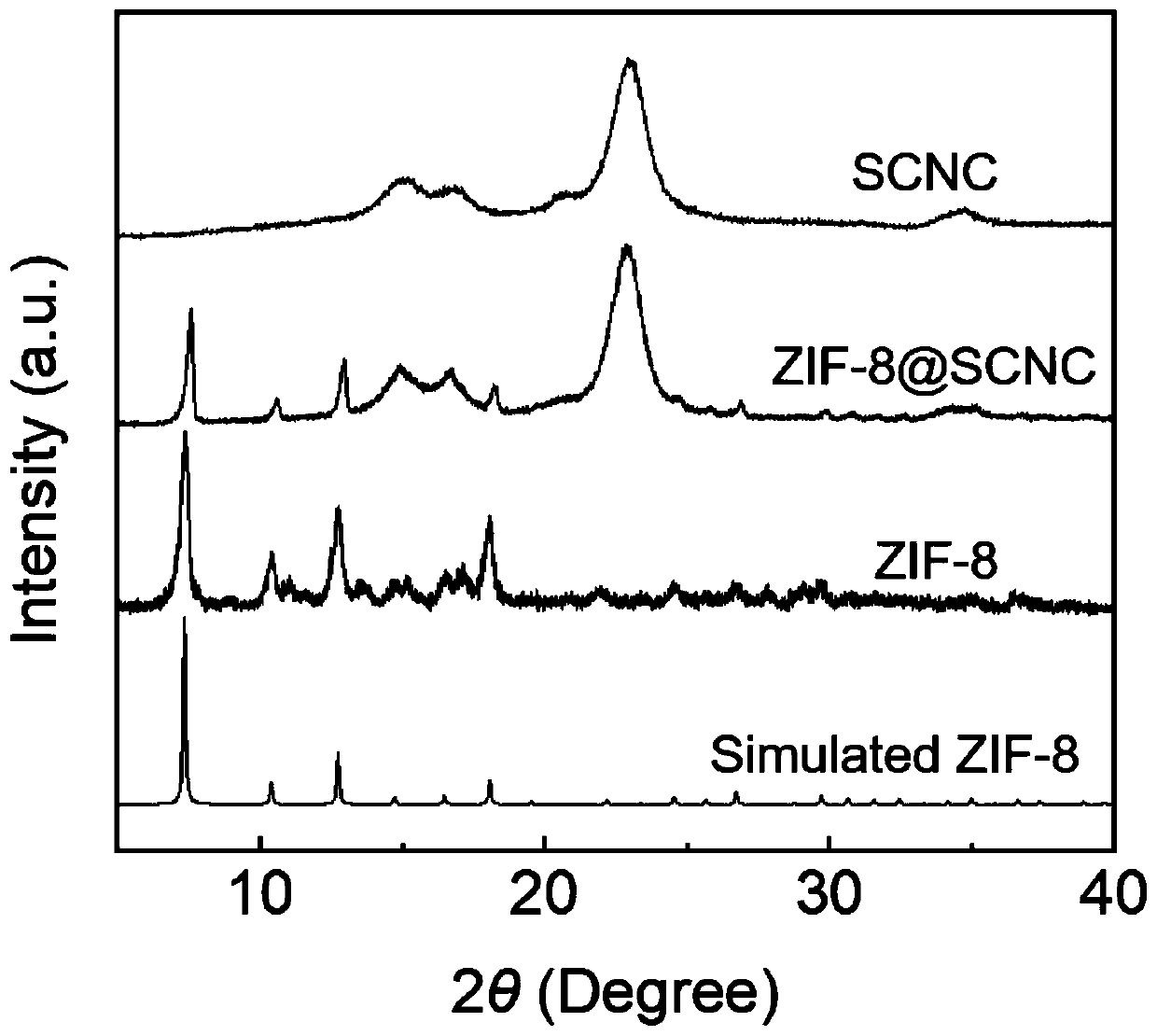Bio-based luminescent nano material and preparation method and application thereof
A nano-material and bio-based technology, applied in the field of materials, can solve the problems of reducing processability and practicability, limiting applications, application obstacles, etc., and achieve the effect of enhancing the effect of resonance scattering
- Summary
- Abstract
- Description
- Claims
- Application Information
AI Technical Summary
Problems solved by technology
Method used
Image
Examples
Embodiment 1
[0043] A bio-based luminescent nanomaterial, the material uses cellulose nanocrystals as the core and ZIF-8 as the shell, wherein the cellulose nanocrystals are aligned in the cavity of the ZIF-8. The material is prepared as follows:
[0044] (1) First, soak 20 g of short-staple cotton in sodium hydroxide alkali solution for alkali treatment, and then mechanically stir and react at a speed of 3500 rpm for 12 hours at room temperature, then wash the obtained cotton with clear water to neutrality, and put it in an oven for 55 Dry at ℃ for 24 hours to obtain alkali-treated cotton. Take 5g of alkali-treated cotton, add it to 45wt% sulfuric acid aqueous solution, and mechanically stir at 3500rpm at 50°C for 30min to obtain a suspension. Put the suspension into an ice bath and cool it to normal temperature, then pour it into Dialyze in a dialysis bag until the solution is neutral to obtain cellulose nanocrystals, denoted as SCNC;
[0045] (2) Add the SCNC and 2-methylimidazole pre...
Embodiment 2
[0059] Preparation of derivatives of bio-based luminescent nanomaterials
[0060] (1) Add citric acid and urea to distilled water at a mass ratio of 1:1 until the citric acid and urea are completely dissolved, then stir the solution at 150°C for 7 hours, and then dialyze with distilled water for 3 days to obtain carbon nanodots, which are denoted as CND ;
[0061] (2) Add the ZIF-8@SCNC prepared in Example 1 to the dispersion of carbon nano-dots obtained in step (1), stir and react for 15h, use distilled water as the washing liquid, and wash 3 times at a speed of 12000rpm, each After 3 minutes, the obtained precipitate was dried to prepare a derivative of bioluminescent nanomaterial (CND@ZIF-8@SCNC).
[0062] Using Talos-f200x transmission electron microscope to test the above CND@ZIF-8@SCNC, the results are as follows Figure 8 shown by Figure 8 It can be seen that carbon nanodots exist in ZIF-8@SCNC, the size of carbon nanodots is below 20nm, and the lattice size is 0.22...
Embodiment 3
[0065] Preparation of derivatives of bio-based luminescent nanomaterials
[0066] (1) Put chloroplatinic acid with a mass fraction of 20% into distilled water, add 1 mL of sodium hydroxide solution with a mass fraction of 50% dropwise at 0°C at a rate of 0.05mL / 3s, and keep the temperature after the addition is completed After stirring and reacting for 1 hour, the temperature was raised to 25° C. and then stirred and reacted for 3 hours to obtain a platinum nanoparticle solution;
[0067] (2) Add the ZIF-8@SCNC prepared in Example 1 to the platinum nanoparticle solution obtained in step (1), stir and react for 15h, use distilled water as the washing liquid, and wash 3 times at a speed of 10000rpm, each time for 3min , and dry the obtained precipitate.
[0068] Figure 10is the nitrogen adsorption-desorption curve of the derivatives of the above-mentioned bio-based luminescent nanomaterials, by Figure 10 It can be seen that the specific surface distribution of the derivativ...
PUM
| Property | Measurement | Unit |
|---|---|---|
| particle diameter | aaaaa | aaaaa |
| size | aaaaa | aaaaa |
Abstract
Description
Claims
Application Information
 Login to View More
Login to View More - R&D
- Intellectual Property
- Life Sciences
- Materials
- Tech Scout
- Unparalleled Data Quality
- Higher Quality Content
- 60% Fewer Hallucinations
Browse by: Latest US Patents, China's latest patents, Technical Efficacy Thesaurus, Application Domain, Technology Topic, Popular Technical Reports.
© 2025 PatSnap. All rights reserved.Legal|Privacy policy|Modern Slavery Act Transparency Statement|Sitemap|About US| Contact US: help@patsnap.com



